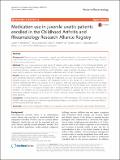| dc.contributor.author | Henderson, Lauren A. | en_US |
| dc.contributor.author | Zurakowski, David | en_US |
| dc.contributor.author | Angeles-Han, Sheila T. | en_US |
| dc.contributor.author | Lasky, Andrew | en_US |
| dc.contributor.author | Rabinovich, C. Egla | en_US |
| dc.contributor.author | Lo, Mindy S. | en_US |
| dc.date.accessioned | 2016-03-01T19:49:10Z | |
| dc.date.issued | 2016 | en_US |
| dc.identifier.citation | Henderson, Lauren A., David Zurakowski, Sheila T. Angeles-Han, Andrew Lasky, C. Egla Rabinovich, and Mindy S. Lo. 2016. “Medication use in juvenile uveitis patients enrolled in the Childhood Arthritis and Rheumatology Research Alliance Registry.” Pediatric Rheumatology Online Journal 14 (1): 9. doi:10.1186/s12969-016-0069-5. http://dx.doi.org/10.1186/s12969-016-0069-5. | en |
| dc.identifier.issn | 1546-0096 | en |
| dc.identifier.uri | http://nrs.harvard.edu/urn-3:HUL.InstRepos:25658377 | |
| dc.description.abstract | Background: There is not yet a commonly accepted, standardized approach in the treatment of juvenile idiopathic uveitis when initial steroid therapy is insufficient. We sought to assess current practice patterns within a large cohort of children with juvenile uveitis. Methods: This is a cross-sectional cohort study of patients with uveitis enrolled in the Childhood Arthritis and Rheumatology Research Alliance (CARRAnet) registry. Clinical information including, demographic information, presenting features, disease complications, and medications were collected. Chi-square and Fisher’s exact tests were used to assess for associations between medications and clinical characteristics. Results: Ninety-two children with idiopathic and 656 with juvenile idiopathic arthritis (JIA)-associated uveitis were identified. Indication (arthritis or uveitis) for medication use was not available for JIA patients; therefore, detailed analysis was limited to children with idiopathic uveitis. In this group, 94 % had received systemic steroids. Methotrexate (MTX) was used in 76 % of patients, with oral and subcutaneous forms given at similar rates. In multivariable analysis, non-Caucasians were more likely to be treated initially with subcutaneous MTX (P = 0.003). Of the 53 % of patients treated with a biologic DMARD, all received a tumor necrosis factor (TNF) inhibitor. TNF inhibitor use was associated with a higher frequency of cataracts (52 % vs 21 %; P = 0.001) and antinuclear antibody positivity (49 % vs 29 %; P = 0.04), although overall complication rates were not higher in these patients. Conclusion: Among idiopathic uveitis patients enrolled in the CARRAnet registry, MTX was the most commonly used DMARD, with subcutaneous and oral forms equally favored. Patients who received a TNF inhibitor were more likely to be ANA positive and have cataracts. Electronic supplementary material The online version of this article (doi:10.1186/s12969-016-0069-5) contains supplementary material, which is available to authorized users. | en |
| dc.language.iso | en_US | en |
| dc.publisher | BioMed Central | en |
| dc.relation.isversionof | doi:10.1186/s12969-016-0069-5 | en |
| dc.relation.hasversion | http://www.ncbi.nlm.nih.gov/pmc/articles/PMC4755024/pdf/ | en |
| dash.license | LAA | en_US |
| dc.subject | Uveitis | en |
| dc.subject | Juvenile idiopathic arthritis (JIA) | en |
| dc.subject | Idiopathic uveitis | en |
| dc.subject | DMARD | en |
| dc.subject | Infliximab | en |
| dc.subject | Adalimumab | en |
| dc.subject | Methotrexate | en |
| dc.title | Medication use in juvenile uveitis patients enrolled in the Childhood Arthritis and Rheumatology Research Alliance Registry | en |
| dc.type | Journal Article | en_US |
| dc.description.version | Version of Record | en |
| dc.relation.journal | Pediatric Rheumatology Online Journal | en |
| dash.depositing.author | Henderson, Lauren A. | en_US |
| dc.date.available | 2016-03-01T19:49:10Z | |
| dc.identifier.doi | 10.1186/s12969-016-0069-5 | * |
| dash.contributor.affiliated | Lo, Mindy | |
| dash.contributor.affiliated | Henderson, Lauren | |
| dash.contributor.affiliated | Zurakowski, David | |


